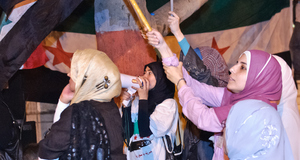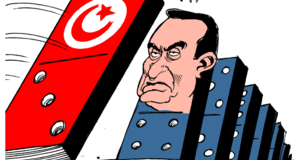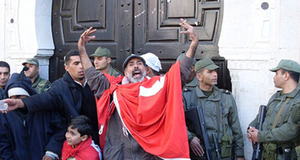Featured Article:The Arab Uprisings and the Blossoming of a 'Global Imaginary'
By
2015, Vol. 7 No. 06 | pg. 3/3 | « The Global Imaginary as a RhizomeThis enjoins a second look at Laclau’s ‘floating signifier’ in the construction of political frontiers. This term can undergo its own elaboration that not only unlocks the potential to dissolve division within the social imaginary, as previously discussed, but also the illusive boundaries between states in the global anarchic system. An important distinction to reiterate is that this frontier cannot move towards a specific endgame, or cosmopolitan utopianism, without violating subjectivity. This is precisely the difficulty that is encountered in Habermas’s deliberative model, which glorifies rational consensus building and the establishment of universal principles within the parameters of a global civil society. His idea is problematic because its constitution involves an oppressive binary, which favors Occidental rationalism over its inversion, Orientalism.7 Furthermore, it relies entirely on rational communication in the public sphere, a space historically dominated by the values of a privileged class, race, and/or sex. In its symbolic arborescence, Habermas’s model also fails to account for the more complex workings of modern communication, such as the interconnectivity circulating through the vessels of modern media, onto which it is impossible to ascribe a specific teleological purpose or desired ending. The signified, ‘grassroots’ civil society, should either be amended or simply left out of the context currently under consideration. The usefulness of its implied vertical and lineal direction, its fixidity to a hierarchical order, is limited when looking at populism in Tunisia and Egypt and the wave of pro-democracy protest that ensued. Civil society, whether domestic or international, failed to provide reliable mediation, in many of these cases, between the social and political spheres. In fact, that vertical relationship was de-legitimized and abandoned. Neither did the democracy being practiced on the streets, explicitly move in the direction of consensus building, or immediately fallback into a vertical or aggregative formation. Rather, ‘grassroots’ momentum spread rhizomaticaly, traversing the globe, and finding moments of articulation at different nodal points in an interconnected schema.Here, a metaphor of the ‘Rhizome’, introduced in Deleuze and Guitarri’s, A Thousand Plateaus, becomes helpful in mapping the erratic logic at play in the journeying of social movements. The Rhizome departs from the linear structuralism proposed in Chomsky’s linguistic tree, which traces the development of language along pathways leading back to deeply-rooted, innate knowledge (Deleuze and Guittari, 1987, p. 12). It also deviates from the structural logic of Habermas’s Theory of Communicative Action, where the trees branches represent movement towards the higher unity of fully rationalized ideal speech- or to continue the metaphor, towards the finality of the leaf, as was previously problematized. Instead, they propose, A rhizome ceaselessly establishes connections between semiotic chains, organizations of power, and circumstances relative to the arts, sciences, and social struggle. A semiotic chain is like a tuber agglomerating very diverse acts, not only linguistic, but also perceptive, mimetic, gestural, and cognitive (Deleuze & Guattari, 1987, p.7). To visualize this arrangement, one might imagine a stand of Aspens, which appear as a colony of individual trees, where in actuality, it is a single living organism with multiple outgrowths, or nodes. A forest fire might destroy these outgrowths, while the subterranean life form, the rhizome of the Aspen, remains unscathed- to regenerate, multiply, and resurface at a later point. As demonstrated in recent pro-democracy protests around the globe, the articulation of different social movements may be silenced by violence, physical or discursive, but they will never be eradicated. The connective rhizome in the social imaginary can manifest somatically, as in examples of stasis, but can also spread through the astral plane, the intangible space where symbolic identity resides, in the unconscious and the collective unconscious. What this novel form of globalized populism has created is a symbolic identity, structured on basic polemic logics, that is no longer confined to a particular geographic location, or reducible to a specific historical sequence. Concluding RemarksThis analysis has focused on recent, consequential developments in Tunisian and Egyptian politics, which have led to a social discourse of hysterics. These protests spread to Libya, Bahrain, North Sudan, and Syria; then to the Spanish Indignados movement, the Aganaktismenoi movement in Syntagma Square, and the Occupy movements in Zuccotti Park, along with hundreds of locations throughout the world. It was a display of democracy in motion, a politics of becoming, linked together by an ‘equivalential chain’. This intra-national, counter-hegemonic articulation was an expression of solidarity against systemic hierarchy and marginalization. There was also a common demand for horizontal and multifarious democracy, more malleable, reflexive, and pragmatic systems, capable of appropriating a variety of democratic practices and models. The democratic ethos that manifested has immense positive potential, demanding both esteem and further development. However, this potential can be severely tempered by a range of ‘institutional deficits’ (Howarth, 2008), which raises serious questions about responsibility in advancing the ideals of social populism within dictatorships. With this being said, it is clear that when the power-potential of the social imaginary is repressed, within our contemporary state of meta-connectivity, when the rhizome is dismembered, new growth will be established, and its nodal points will multiply, in infinite reincarnations, emboldened in the eternal promise: ‘If you don’t let us dream, we wont let you sleep’! 8 ReferencesAthanasiou, Athena and Butler, Judith. (2013) Dispossession: The Performative in the Political. Polity Press. Cambridge, UK. Boli, John & Thomas, George M. (1999) Constructing World Culture: International Nongovernmental Organizations Since 1875. Stanford University Press, Stanford,California. Bracher, Mark. (1993) Lacan, Discourse, and Social Change: A Psychoanalytic Cultural Criticism. Cornell University Press. Ithaca, New York. Campbell, David. (1998) “Why Fight: Humanitarianism, Principles, and Post-structuralism.” Millennium Journal of international Studies, 27: 497-521. Collins, Victoria E. & Rothe, Dawn L. (2012) “United States Support for Global SocialJustice? Foreign Intervention and Realpolitik in Egypt’s Arab Spring.” Social Justice, 39.4: 1-30. Delueze, Gilles & Guattari, Felix. (1987) A Thousand Plateaus: Capitalism and Schizophrenia. University of Minnesota Press. Minneapolis, Minnesota. Durac, Vincent. (2013) “Protest Movements and Political Change: an Analysis of the ‘ArabUprisings’ of 2011.” Journal of Contemporary African Studies, 31.2: 175-193. Hansen, Allan D. (2010) “Dangerous Dogs, Constructivism and Normativity: The Implications of Radical Constructivism.” Distinktion: Scandinavian Journal of Social Theory, 11: 93-107. Economist. “The Arab Spring Death Toll: The Price of Protest, so far.” July 14, 2011 Epstein, Charlotte. (2013) “Constructivism or the Eternal Return of Universals inInternational Relations. Why Returning to Language is Vital to prolonging the Owl’s Flight.” European Journal of International Relations, 19.3: 499-519. Garwood-Gowers, Andrew. (2013) “The Responsibility to Protect and the Arab Spring:Libya as the Exception, Syria as the Norm?” University of New South Wales Law Journal, 36.2: 594-618. Gramsci, Antonio. (1999) Selections From the Prison Notebooks. International Publishers. New York, New York. Guessomumi, Mouldi. (2012) “The Grammars o the Tunisian Revolution.” Boundary 2, 39.1: 17-42. Hale, Sondra. (2014) “The New Middle East Insurrections and Other Subversions of the Modernist Frame.” Journal of Middle East Women’s Studies. Howarth R., David. (2008) “Ethos, Agonism and Populism: William Connolly and the Case for Radical Democracy.” British Journal of Politics and International Relations, 10: 171-193. Ibnouf, Fatma Osman. (2013) “Women and the Arab Spring: A Window of Opportunity or More of the Same?” Women & Environments 92/93: 18-21. Ismael, Jacqualine S. & Ismael, Shereen T. (2013) “The Arab Spring and the Uncivil State.” Arab Studies Quarterly, 35.3: 229-240. Johansson-Nougues, Elisabeth. (2013) “Gendering the Arab Spring? Rights and (in)security of Tunisian, Egyptian and Libyan Women.” Security Dialogue. 44.5-6: 393-409. Ketchley, Neil. (2014) “The Army and the People are One Hand! Fraternization and the 25th January Egyptian Revolution.” Comparative Studies in Society and History, 56.1: 155-186. Laclau, Ernesto. (2005) On Populist Reason. Verso. London, UK. Laclau, Ernesto & Mouffe, Chantal. (1985) Hegemony and Socialist Strategy: Towards a Radical Democratic Politics. Verso. London UK. Litsas, Spyridon Nikolaou. (2013) “Stranger in a Strange Land: Thucydides’ Stasis and the Arab Spring.” Digest of Middle East Studies, 22.2: 361-376. Mabon, Simon. (2013) “Aiding Revolution? Wikileaks, Communication and the ‘ArabSpring’ in Egypt.” Third World Quarterly, 34.10: 1843-1857. Moghadam, Valentine M. (2012) “Engendering Democracy After the Arab Spring.” Journal of the Indiana Academy of the Social Sciences. 15: 1-20. Moghadam, Valentine M. (2014) “Democratization and Women’s Political Leadership in North Africa. Journal of international affairs 68.1: 59-78. Mouffe, Chantal. (1996) Deconstruction and Pragmatism: Critchley, Derrida, Laclau,Rorty. Routledge, New York, NY. Mouffe, Chantal. (2013) Agonistics: Thinking the World Politically. Verso. London, UK. Nederveen, Jan P. (2012) “Leaking Superpower: Wikileaks and the Contradictionsof Domocracy.” Third World Quarterly, 33.10: 1909-1924. Outhwaite, William & Ray, Larry. (2005) Social Theory and Postcommunism. Blackwell Publishing. Malden, Massachusetts. Pratt, Nicola. (2012) “The Gender Logics of Resistance to the ‘War on Terror’: Constructing Sex-Gender Difference Through the Erasure of Patriarchy in the Middle East.” Third World Quarterly 33.10: 1821-1836. Said, Edward W. (1979) Orientalism. Vintage Books Edition, Random House. New York, New York. Schraeder, Peter J. (2012) “Tunisia’s Jasmine Revolution and the Arab Spring: Implications for international Intervention.” Orbis, 56.4: 662-675. Selim, Gamal M. (2013) “The United States and the Arab Spring: The Dynamics of Political Engineering.” Arab Studies Quarterly, 35.3: 255-271. Singerman, Diane. (2013) “Youth, Gender, and Dignity in the Egyptian Uprising.” Journal of Middle East Women’s Studies 9.3: 1-27. Williams, Paul R. and Popken, Colleen. (2012) “U.S. Foreign Policy and the Arab Spring: Ten Short-Term Lessons Learned.” Denver Journal of International Law and Policy 41.1: 47-61 Zehfuss, Maja. (2002) Constructivism in International Relations: The Politics of Reality. Cambridge Studies in International Relations. Cambridge, UK. Zizek, Slovoj. (1989) The Sublime Object of Ideology. Verso. London, UK. Endnotes
Suggested Reading from Inquiries Journal
Inquiries Journal provides undergraduate and graduate students around the world a platform for the wide dissemination of academic work over a range of core disciplines. Representing the work of students from hundreds of institutions around the globe, Inquiries Journal's large database of academic articles is completely free. Learn more | Blog | Submit Latest in Political Science |


















